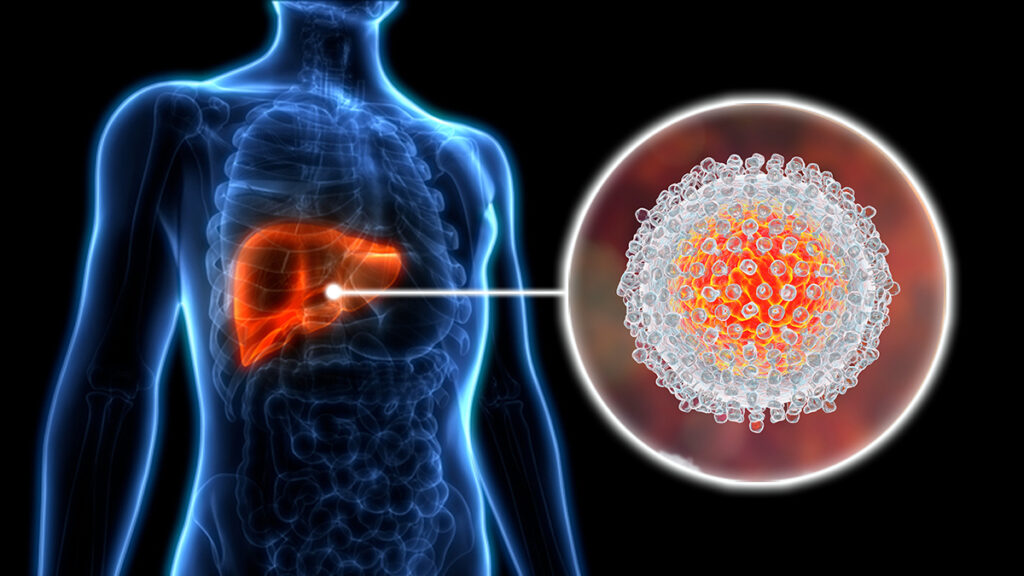What is Chronic Hepatitis C?
Chronic hepatitis C is a long-term liver infection caused by HCV, a bloodborne virus. Unlike acute hepatitis C, which resolves within six months, chronic hepatitis C persists, potentially leading to severe liver damage. If untreated, it may result in cirrhosis, liver failure, or hepatocellular carcinoma (HCC).

Key Facts about HCV
- Transmission: Primarily through blood-to-blood contact, including shared needles, contaminated medical equipment, and unscreened blood transfusions.
- Global Prevalence: According to the World Health Organization (WHO), approximately 58 million people live with chronic hepatitis C globally.
- Genotypes: HCV has six major genotypes, with variations in treatment response.
Symptoms
Chronic hepatitis C is often called a “silent disease” due to its asymptomatic nature in the early stages. Common symptoms include:
- Fatigue: Persistent tiredness and lack of energy.
- Jaundice: Yellowing of the skin and eyes due to elevated bilirubin levels.
- Abdominal Pain: Particularly in the upper right quadrant, near the liver.
- Dark Urine and Pale Stools: Indicative of liver dysfunction.
- Unexplained Weight Loss: A sign of advanced liver disease.
- Itchy Skin: Often caused by bile salt deposits.
Diagnosis
Early diagnosis is critical for preventing long-term complications. The diagnostic process includes:
1. Screening Tests
- Anti-HCV Antibody Test: Detects exposure to the virus.
- HCV RNA Test: Confirms active infection and measures viral load.
2. Liver Function Tests (LFTs)
- Assesses enzyme levels like ALT and AST to evaluate liver health.
3. Imaging Studies
- Ultrasound: Identifies liver abnormalities, such as fibrosis or cirrhosis.
- Transient Elastography (FibroScan): Measures liver stiffness as an indicator of fibrosis.
4. Liver Biopsy
- Occasionally performed to assess liver damage severity.
Treatment Options
Advancements in medical science have made chronic hepatitis C curable in most cases. Treatment primarily involves direct-acting antivirals (DAAs).
Direct-Acting Antivirals (DAAs)
DAAs target specific proteins essential for HCV replication. Key benefits include:
- High Cure Rates: Over 95% of patients achieve sustained virologic response (SVR).
- Short Treatment Duration: Typically 8 to 12 weeks.
- Fewer Side Effects: Compared to older treatments like interferon-based therapy.
Other Treatment Considerations
- Liver Transplantation: For patients with advanced liver disease.
- Lifestyle Changes: Avoiding alcohol, maintaining a healthy weight, and regular exercise can support liver health.
Prevention Strategies
Preventing HCV infection is crucial to reducing its global burden. Effective prevention strategies include:
- Safe Injection Practices: Using sterile needles and syringes.
- Screening Blood Products: Ensuring all donated blood is tested for HCV.
- Education: Raising awareness about the risks of unsafe tattooing, piercing, and intravenous drug use.
- Vaccination: While no vaccine exists for HCV, vaccination against hepatitis A and B is recommended for those with chronic hepatitis C.
Complications
If untreated, chronic hepatitis C can lead to severe complications:
- Cirrhosis: Scarring of liver tissue that impairs function.
- Hepatocellular Carcinoma (HCC): A primary liver cancer associated with chronic HCV.
- Liver Failure: Loss of liver function requiring transplantation.
Living with Chronic Hepatitis C
Managing chronic hepatitis C involves both medical treatment and lifestyle adjustments. Key recommendations include:
- Regular Monitoring: Routine check-ups to assess liver health.
- Nutritional Support: A balanced diet rich in fruits, vegetables, and lean proteins.
- Mental Health Care: Addressing anxiety or depression often associated with chronic illness.
Prognosis and Outlook
With timely diagnosis and treatment, the prognosis for chronic hepatitis C has improved dramatically. Achieving SVR significantly reduces the risk of complications and improves quality of life.